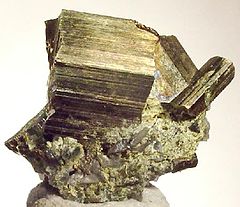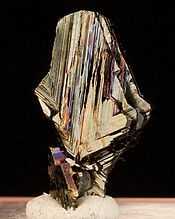- Cubanite
-
Cubanite 
Striated, cyclically-twinned cubanite crystals from the Chibougamau mines of Quebec. (size: 1.5 x 1.3 x 1.0 cm)General Category Sulfide mineral Chemical formula CuFe2S3 Strunz classification 02.CB.55a Crystal symmetry Orthorhombic (2/m 2/m 2/m) - dipyramidal Unit cell a = 6.467(1) Å, b = 11.117(1) Å, c = 6.231(2) Å; Z = 4 Identification Color Bronze to brass-yellow Crystal habit Crystals elongated to thick tabular, striated also massive Crystal system Orthorhombic Twinning Common with twin plane {110} in pairs, also as fourlings and pseudohexagonal sixlings Cleavage Parting on {110} and {130} Fracture Conchoidal Mohs scale hardness 3.5-4 Luster Metallic Streak Black Diaphaneity Opaque Specific gravity 4.0-4.2 Optical properties Distinctly anisotropic on polished surface Other characteristics Strongly magnetic References [1][2][3]  Iridescent and highly lustrous brass-yellow cubanite crystal from Chibougamau, Quebec (size: 1.7 x 1.0 x 0.7 cm)
Iridescent and highly lustrous brass-yellow cubanite crystal from Chibougamau, Quebec (size: 1.7 x 1.0 x 0.7 cm)
Cubanite is a yellow mineral of copper, iron, and sulfur, CuFe2S3.[3]
Cubanite was first described in 1843 for an occurrence in the Mayarí-Baracoa Belt, Oriente Province, Cuba.[1]
Cubanite occurs in high temperature hydrothermal deposits with pyrrhotite and pentlandite as intergrowths with chalcopyrite. It results from exsolution from chalcopyrite at temperatures below 200 to 210 °C.[2] It has also been reported from carbonaceous chondrite meteorites.[2]
References
- ^ a b Mindat.org
- ^ a b c Handbook of Mineralogy
- ^ a b Webmineral
- Schumann, Walter (1991). Mineralien aus aller Welt. BLV Bestimmungsbuch (2 ed.). pp. 223. ISBN 3-405-14003-X.
This article about a specific sulfide mineral is a stub. You can help Wikipedia by expanding it.
